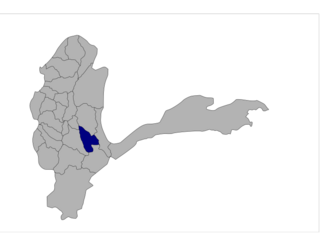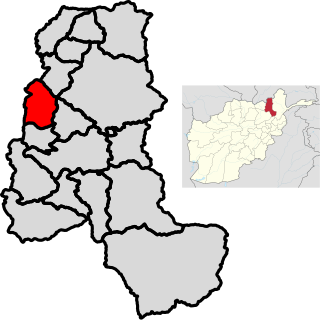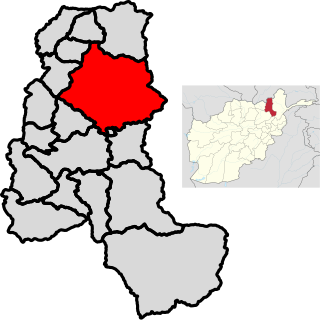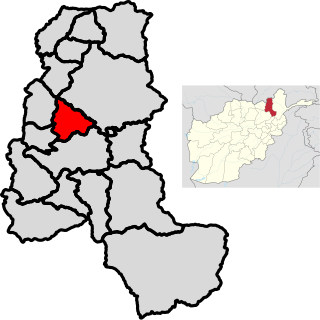
Badakhshan is a historical region comprising parts of modern-day north-eastern Afghanistan, eastern Tajikistan, and Taxkorgan Tajik Autonomous County in China. Badakhshan Province is one of the 34 provinces of Afghanistan. Much of historic Badakhshan lies within Tajikistan's Gorno-Badakhshan Autonomous Region in the southeastern part of the country. The music of Badakhshan is an important part of the region's cultural heritage.

Badakhshan Province is one of the 34 provinces of Afghanistan, located in the northeastern part of the country. It is bordered by Tajikistan's Gorno-Badakhshan in the north and the Pakistani regions of Lower and Upper Chitral and Gilgit-Baltistan in the southeast. It also has a 91-kilometer (57-mile) border with China in the east.

The Bartang is a river of Central Asia, and is a tributary to the Panj which itself is a tributary to the Amu Darya. In its upper reaches, it is also known as the Murghab and Aksu; it flows through the Wakhan in Afghanistan, then through the Rushon District of the Gorno-Badakhshan autonomous region, Tajikistan. The river is 528 kilometres (328 mi) long and has a basin area of 24,700 square kilometres (9,500 sq mi).

Shuhada is one of the 29 districts of Badakhshan province in eastern Afghanistan. The district was formed in 2005 from part of Baharak District and is home to approximately 38,387 residents.

Wurduj is one of the 28 districts of Badakhshan province in eastern Afghanistan. It was created in 2005 from part of Baharak District and is home to approximately 24,285 residents. Total area of the district is 929 square kilometers. 45 villages are located within its borders. Ethnic composition: 90% Tajik and 10% Uzbek.

Ishkoshim District or Nohiya-i Ishkoshim is a district in eastern Tajikistan, in the extreme south-west of the Gorno-Badakhshan Autonomous Region (GBAO). It borders Afghanistan along the river Panj to the south and to the west. The population of Ishkoshim district is 32,900.

Kalafgan District is a district of Takhar Province, Afghanistan. The district is well governed, with self-governance in parts of Kalafgan because of how remote they are. 42 villages are located in the district. In 2017, Kalafgan was considered to be under full control by the Afghan Government. However, the Taliban had taken full control by August 2021.

Khwaja Ghar District is a district of Takhar Province, Afghanistan. The district was badly destroyed during the 1996-2001 Afghan Civil War in fighting between the Taliban and the Northern Alliance.

Rustaq District is a district of Takhar Province, northern Afghanistan. The district centre is the town of Rostaq.
Amurn is a village in Darwaz District, Badakhshan Province in north-eastern Afghanistan.
Ashnam is a village in Badakhshan Province in north-eastern Afghanistan.
Baharak is a small town and seat of Baharak District Badakhshan Province in north-eastern Afghanistan. It is roughly 15 kilometers from Jurm, on the Kokcha River. Baharak Girls' School was opened on December 17, 2006, by Munshi Abdul Majeed the Governor of Badakhshan Province, it serves about 3000 girls who attend in three separate shifts during the day.
Farghamu is a village in Badakhshan Province in north-eastern Afghanistan. It lies on the left bank of a stream in a valley of the Upper Kokcha River. The ground is generally laid out in fields. It is located on the frontier of the Shia-Posh Kafirs. Around the turn of the 20th century, roughly 30 families lived here. At that time, there was no bridge or ford of the river there.
Kakan is a village in Badakhshan Province in north-eastern Afghanistan. It lies on the northern part of the Kokcha River, roughly 25 miles northeast of Fayzabad.
Khash Darreh is the name of two villages in Badakhshan Province in north-eastern Afghanistan.
Qalʽeh-ye Panjeh, also written Qila-e Panjeh and Kala Panja, is a village in Wakhan, Badakhshan Province in north-eastern Afghanistan. It lies on the Panj River, near the confluence of the Wakhan River and the Pamir River.

The Kokcha River is located in northeastern Afghanistan. A tributary of the Panj river, it flows through Badakhshan Province in the Hindu Kush. It is named after the Koksha Valley. The city of Feyzabad lies along the Kokcha. Near the village of Artin Jelow there is a bridge over the river.

Fayzabad also spelled Feyzabad or Faizabad is a city in northeastern Afghanistan, with a population of around 39,555 people. It serves as the provincial capital and largest city of Badakhshan Province. It is situated in Fayzabad District and is at an altitude of 1,254 m (4,114 ft).

Baharak District is a district of Takhar Province, Afghanistan. The district was split-off from Taluqan District in 2005. Most people work in agriculture. The district has been the site of fighting between the Afghan Government and the Taliban; Baharak was considered to be contested in late 2018 and taken by the Taliban by August 2021.

Hazar Sumuch District is a district of Takhar Province, Afghanistan. The district was split-off from Taluqan District. Most people in the district work in agriculture. In late 2018, Hazar Sumuch was considered to be government influenced as opposed to the Taliban.














